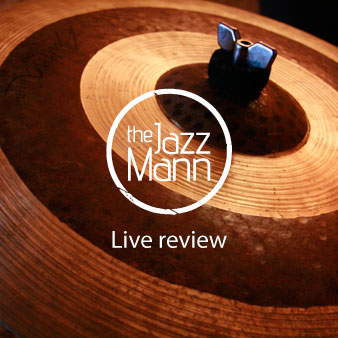
by Tim Owen
September 09, 2009
/ LIVE
Murray is the magic ingredient that makes this trio so magnificent
Tony Bevan; bass, tenor and soprano saxophones
John Edwards; double bass
Sunny Murray; drums
Sunny Murray plays a fairly basic kit: just bass, floor tom and snare drums, plus hi-hat, crash and ride cymbals. The crash cymbal has a small chain running down it; the ride cymbal is split. For one passage he swaps his sticks for metal brushes. And that’s it. He focuses predominantly on the snare and bass drums, laying down constantly shifting variations on one abstracted snare rhythm over an emphatic, irregular bass drum pulse, and resorts to the tom only for the occasional punctuation or tension-releasing climax. For long passages he sustains a constant, complementary sheet of ringing stick work on the splash cymbal, or a replication of the same effect on the hi-hat. It’s a tightly focused approach, and Murray lays back into it, muttering or perhaps quietly chanting incantations; tight and effective.
Murray is in a sociable mood even before the show, taking the stage early to chat to the audience. On introducing Bevan and Edwards he comments “we’re the best; I don’t know what at, but we’re the best”. But he seems restless. He drops his sticks, and stops playing to adjust his kit. In the second set he exchanges his drum stool for a spindly wooden chair from the front row, with inevitable consequences. During an intermission Q&A he admits (and it’s true) that Bevan and Edwards “kicked my ass tonight”. But he does settle down during the first set, and is more focused in the second, which he ends by appreciatively turning to his companions to mutter “beautiful, gentlemen, beautiful”. And so it was. None of the above should be taken to infer that Murray is anything less than a powerful and compelling performer. At 73 years of age he may not be the unexpected storm that shook up jazz in the early 60s but he’s no nostalgia act. Anyone who can take to the stage with Bevan and Edwards on an equal footing deserves respect; Murray has a lot of additional weight to carry: it can’t be easy being a Jazz legend. But Murray’s current rep doesn’t rest on his contributions to Jazz history. The passion and feeling he invests in his drumming is palpable and energising; more than that this trio works wonderfully well together in that special way that only the most congruous partnerships do.
The trio follow three lines of mostly parallel development. Murray lays down his sheets of sound, freeing Edwards to exploit his precise, attacking style to the full. Edwards really rips into the rhythmic possibilities, concentrating mostly on finger work, driving things forwards, sometimes at a ferocious pace. Tony Bevan meanwhile explores complementary lines of melodic development. Sometimes, appropriately enough, he evokes Murray’s old band leader Albert Ayler, but he also pushes outwards into territories opened up by the likes of Archie Shepp, David S Ware, and precious few other free-players who likewise integrate song-based blues and R ‘n’ B inflections into an otherwise fierce blowing style. In one long, vocal passage on bass saxophone he brings a bluesy quality to a long line of staccato ?phuts’ that act as a riff around which the music coalesces in a long diminuendo.
I suspect that, as Murray hinted, he wasn’t on top form this night, but he was still terriffic. There can be no doubt that he’s the magic ingredient that makes this trio so magnificent, notwithstanding the peerless work Bevan and Edwards do elsewhere. With the recent Sunny’s Time Now documentary and two CDs to date on Bevan’s Foghorn label, this trio has become an established working unit, and I hope the association lasts.
blog comments powered by Disqus